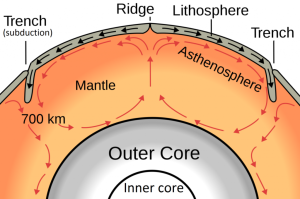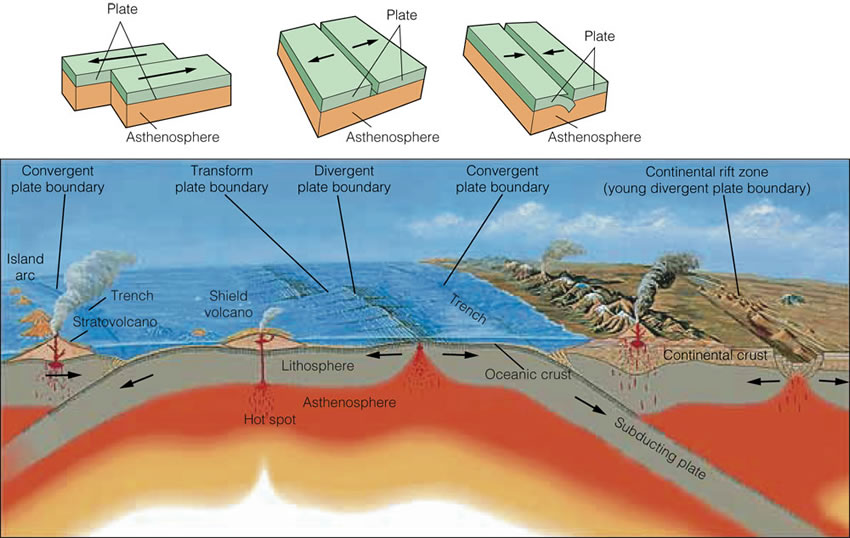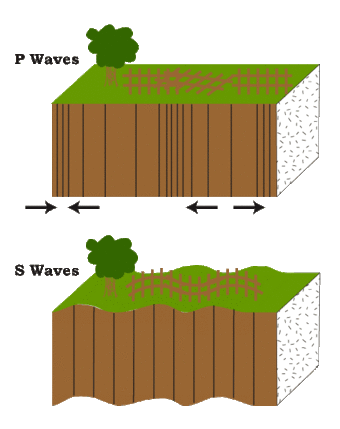7 USGS: Science of Quakes
Originally written by Lisa Wald (U.S. Geological Survey) for “The Green Frog News”. Recently posted at usgs.gov.
What is an earthquake?
An earthquake is what happens when two blocks of the earth suddenly slip past one another. The surface where they slip is called the fault or fault plane. The location below the earth’s surface where the earthquake starts is called the hypocenter, and the location directly above it on the surface of the earth is called the epicenter.
Sometimes an earthquake has foreshocks. These are smaller earthquakes that happen in the same place as the larger earthquake that follows. Scientists can’t tell that an earthquake is a foreshock until the larger earthquake happens. The largest, main earthquake is called the mainshock. Mainshocks always have aftershocks that follow. These are smaller earthquakes that occur afterwards in the same place as the mainshock. Depending on the size of the mainshock, aftershocks can continue for weeks, months, and even years after the mainshock!
The Physical Component: What causes earthquakes and where do they happen?

The earth has four major layers: the inner core, outer core, mantle and crust. The crust and the top of the mantle make up a thin skin on the surface of our planet.
But this skin is not all in one piece – it is made up of many pieces like a puzzle covering the surface of the earth. Not only that, but these puzzle pieces keep slowly moving around, sliding past one another and bumping into each other. We call these puzzle pieces tectonic plates, and the edges of the plates are called the plate boundaries. The plate boundaries are made up of many faults, and most of the earthquakes around the world occur on these faults. Since the edges of the plates are rough, they get stuck while the rest of the plate keeps moving. Finally, when the plate has moved far enough, the edges unstick on one of the faults and there is an earthquake.

Movement: Why does the earth shake when there is an earthquake?
While the edges of faults are stuck together, and the rest of the block is moving, the energy that would normally cause the blocks to slide past one another is being stored up. When the force of the moving blocks finally overcomes the friction of the jagged edges of the fault and it unsticks, all that stored up energy is released. The energy radiates outward from the fault in all directions in the form of seismic waves like ripples on a pond. The seismic waves shake the earth as they move through it, and when the waves reach the earth’s surface, they shake the ground and anything on it, like our houses and us!
The plates move because of convections cells in the mantle. Heat and pressure due to radioactive decay and gravity is not perfectly evenly distributed. In regions of greater heat and energy in the mantle, plumes of hot magma rise toward the crust. From that rising region, the material spreads out and drags the overlying plate with it. Eventually the mantle material cools and sinks and drags the plate down.

The vast majority of earth quakes happen along plate boundaries. By mapping the location of quakes, we’re able to find the boundaries of plates. At any one boundary, the two plates involved can move either towards each other (convergent boundary), away from each other (divergent boundary) or side-by-side (transform boundary). Depending on the type of plates involved (continental or oceanic) and the direction of movement, different landforms are created.

Measuring Quakes: How are earthquakes recorded?

Earthquakes are recorded by instruments called seismographs. The recording they make is called a seismogram. The seismograph has a base that sets firmly in the ground, and a heavy weight that hangs free. When an earthquake causes the ground to shake, the base of the seismograph shakes too, but the hanging weight does not. Instead the spring or string that it is hanging from absorbs all the movement. The difference in position between the shaking part of the seismograph and the motionless part is what is recorded.
How do scientists measure the size of earthquakes?

The size of an earthquake depends on the size of the fault and the amount of slip on the fault, but that’s not something scientists can simply measure with a measuring tape since faults are many kilometers deep beneath the earth’s surface. So how do they measure an earthquake? They use the seismogram recordings made on the seismographs at the surface of the earth to determine how large the earthquake was (figure 5). A short wiggly line that doesn’t wiggle very much means a small earthquake, and a long wiggly line that wiggles a lot means a large earthquake. The length of the wiggle depends on the size of the fault, and the size of the wiggle depends on the amount of slip.
The size of the earthquake is called its magnitude. There is one magnitude for each earthquake. Scientists also talk about the intensity of shaking from an earthquake, and this varies depending on where you are during the earthquake.
Where: How do we know it was there?

A normal (dip-slip) fault is an inclined fracture where the rock mass above an inclined fault moves down (Public domain.)
Seismograms come in handy for locating earthquakes too, and being able to see the P wave and the S wave is important. You learned how P & S waves each shake the ground in different ways as they travel through it. P waves are also faster than S waves, and this fact is what allows us to tell where an earthquake was. To understand how this works, let’s compare P and S waves to lightning and thunder. Light travels faster than sound, so during a thunderstorm you will first see the lightning and then you will hear the thunder. If you are close to the lightning, the thunder will boom right after the lightning, but if you are far away from the lightning, you can count several seconds before you hear the thunder. The further you are from the storm, the longer it will take between the lightning and the thunder.

P waves are like the lightning, and S waves are like the thunder. The P waves travel faster and shake the ground where you are first. Then the S waves follow and shake the ground also. If you are close to the earthquake, the P and S wave will come one right after the other, but if you are far away, there will be more time between the two.
By looking at the amount of time between the P and S wave on a seismogram recorded on a seismograph, scientists can tell how far away the earthquake was from that location. However, they can’t tell in what direction from the seismograph the earthquake was, only how far away it was. If they draw a circle on a map around the station where the radius of the circle is the determined distance to the earthquake, they know the earthquake lies somewhere on the circle. But where?
Scientists then use a method called triangulation to determine exactly where the earthquake was (see image below). It is called triangulation because a triangle has three sides, and it takes three seismographs to locate an earthquake. If you draw a circle on a map around three different seismographs where the radius of each is the distance from that station to the earthquake, the intersection of those three circles is the epicenter!

Triangulation can be used to locate an earthquake. The seismometers are shown as green dots. The calculated distance from each seismometer to the earthquake is shown as a circle. The location where all the circles intersect is the location of the earthquake epicenter. (Public domain.)
When: The timing of quakes.?
Prediction
We can not predict when a quake will happen, and it is unlikely they will ever be able to predict them. Scientists have tried many different ways of predicting earthquakes, but none have been successful. On any particular fault, scientists know there will be another earthquake sometime in the future, but they have no way of telling when it will happen.
What we can do is provide a probability, or likelihood, expressed as a percentage, that a quake of a certain size will happen during a specified period of time and in a certain area.
Rumors of Rumbling
There have been rumors and reports of strange animal behavior before quakes ever since the ancient Greeks. Can some animals or people tell when an earthquake is about to hit? We don’t yet have a definitive answer to that. At the present time, if there are some animals that are able to sense quakes in advance, we don’t know how to reliably interpret the behavior from the animals in time for the behavior to be a useful warning for us.
If weather affects earthquake occurrence, we do not yet understand how it works either.

